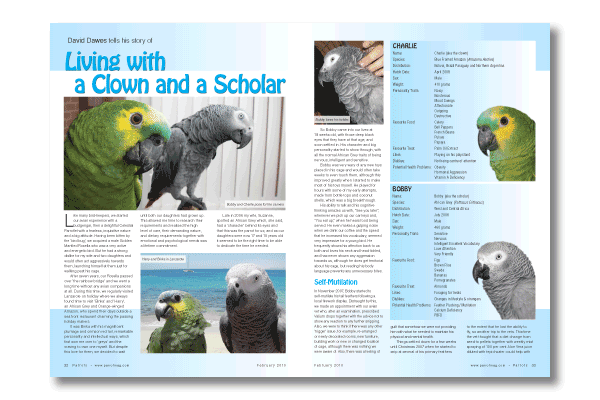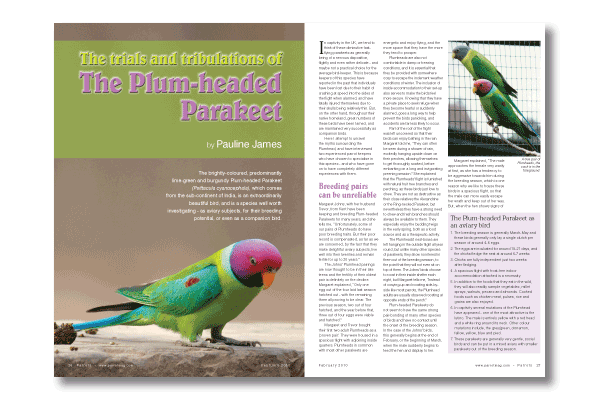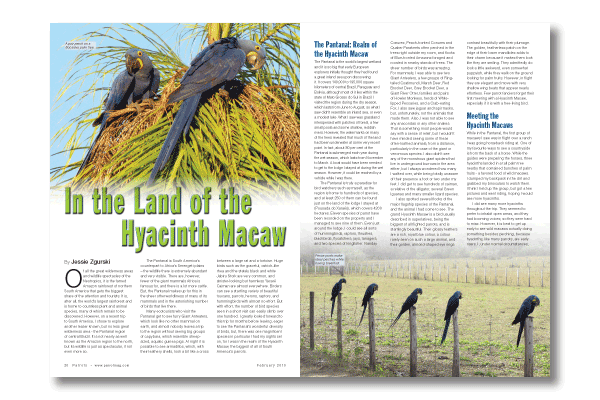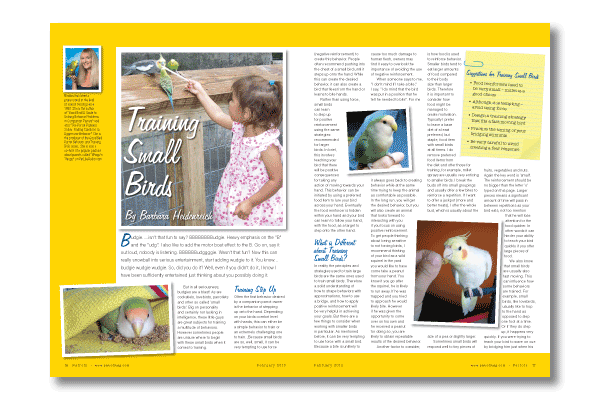
David Dawes
Like many bird-keepers, we started our avian experience with a budgerigar, then a delightful Celestial Parrotlet with a fearless, inquisitive nature and a big attitude. Having been bitten by the ‘bird bug’, we acquired a male Golden Mantled Rosella who was a very active and energetic bird. But he had a strong dislike for my wife and two daughters and would often act aggressively towards them, launching himself at them just for walking past his cage.
After seven years, our Rosella passed over ‘the rainbow bridge’ and we went a long time without any avian companions at all. During this time, we regularly visited Lanzarote on holiday where we always found time to visit ‘Binka’ and ‘Harry’, an African Grey and Orange-winged Amazon, who spend their days outside a sea front restaurant charming the passing holiday makers.
It was Binka with his magnificent plumage and crimson red tail, remarkable personality and intellectual ways, which first won me over to ‘greys’ and the craving to own one myself. But despite this love for them, we decided to wait until both our daughters had grown up. This allowed me time to research their requirements and realised the high level of care, their demanding nature, and dietary requirements together with emotional and psychological needs was a lifetime commitment.
Late in 2006 my wife, Suzanne, spotted an African Grey which, she said, had a ‘character’ behind its eyes and that this was the parrot for us, and as our daughters were now 17 and 19 years old it seemed to be the right time to be able to dedicate the time he needed.
So Bobby came into our lives at 18 weeks old, with those deep black eyes that they have at that age, and soon settled in. His character and big personality started to show through, with all the normal African Grey traits of being nervous, intelligent and sensitive.
Read more in the magazine…
Buy a copy now!
BACK

Pauline James
In captivity in the UK, we tend to think of these diminutive fast-flying parakeets as generally being of a nervous disposition, flightly and even rather delicate - and maybe not a practical choice for the average bird-keeper. This is because keepers of this species have reported in the past that individuals have been lost due to their habit of crashing at speed into the sides of the flight when alarmed, and have fatally injured themselves due to their skulls being relatively thin. But, on the other hand, throughout their native homeland, great numbers of these birds have been tamed, and are maintained very successfully as companion birds.
Here I attempt to unravel the myths surrounding the Plumhead, and have interviewed two experienced parrot keepers who have chosen to specialise in this species - and who have gone on to have completely different experiences with them.
Breeding pairs can be unreliable
Margaret Johns, with her husband Trevor, from Kent have been keeping and breeding Plum-headed Parakeets for many years, and she tells me, “Unfortunately, some of our pairs of Plumheads do have poor breeding traits. But their poor record is compensated, as far as we are concerned, by the fact that they make delightful aviary subjects, live well into their twenties and remain fertile for up to 20 years.”
The Johns’ Plumhead pairings are now thought to be in their late teens and the fertility of their oldest pair is definitely on the decline. Margaret explained, “Only one egg out of the four laid last season hatched out - with the remaining three all proving to be clear. The previous season, two out of four hatched, and the year before that, three out of four eggs were viable and hatched.”
Margaret and Trevor bought their first two adult Plumheads as a ‘proven pair.’ They were housed in a spacious flight with adjoining inside quarters. Plumheads in common with most other parakeets are energetic and enjoy flying, and the more space that they have the more they tend to prosper.
Read more in the magazine…
Buy a copy now!
BACK

Jessie Zgurski
Of all the great wilderness areas and wildlife spectacles of the Neotropics, it is the famed Amazon rainforest of northern South America that gets the biggest share of the attention and tourists. It is, after all, the world’s largest rainforest and is home to countless plant and animal species, many of which remain to be discovered. However, on a recent trip to South America, I chose to explore another lesser known, but no less great wilderness area - the Pantanal region of central Brazil. It is not nearly as well known as the Amazon region to the north, but its wildlife is just as spectacular, if not even more so.
The Pantanal is South America’s counterpart to Africa’s Serengeti plains – the wildlife there is extremely abundant and very visible. There are, however, fewer of the giant mammals Africa is famous for, and there is a lot more cattle. But, the Pantanal makes up for this in the sheer otherworldliness of many of its mammals and in the astonishing number of birds that live there.
Many ecotourists who visit the Pantanal get to see furry Giant Anteaters, which look like no other mammal on earth, and almost nobody leaves a trip to the region without seeing big groups of capybara, which resemble sheep-sized, aquatic guinea pigs. At night it is possible to see armadillos, which, with their leathery shells, look a bit like a cross between a large rat and a tortoise. Huge birds such as the graceful, ostrich-like rhea and the stately black and white Jabiru Stork are very common, and sinister-looking but harmless Yacaré Caiman are almost everywhere. Birders can see a startling variety of beautiful toucans, parrots, herons, raptors, and hummingbirds with almost no effort. But with effort, the number of bird species seen in a short visit can easily climb over one hundred. I greatly looked forward to this trip for months before leaving, eager to see the Pantanal’s wonderful diversity of birds, but, there was one magnificent species in particular I had my sights set on, for I was in the realm of the Hyacinth Macaw, the biggest of all of South America’s parrots.
Read more in the magazine…
Buy a copy now!
BACK

Barbara Heidenreich
Budgie…..isn’t that fun to say? BBBBBBBBudgie. Heavy emphasis on the “B” and the “udg”. I also like to add the motor boat effect to the B. Go on, say it out loud, nobody is listening. BBBBBBudggggie. Wasn’t that fun? Now this can really snowball into serious entertainment, start adding wudgie to it. You know… budgie wudgie wudgie. So, did you do it? Well, even if you didn’t do it, I know I have been sufficiently entertained just thinking about you possibly doing it.
But in all seriousness, budgies are a blast! As are cockatiels, lovebirds, parrotlets and other so called ‘small birds.’ Big on personality and certainly not lacking in intelligence, these little guys are great subjects for training a multitude of behaviors. However sometimes people are unsure where to begin with these small birds when it comes to training.
Read more in the magazine…
Buy a copy now!
BACK




